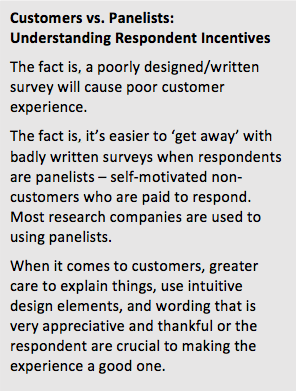When it comes to customer experience insights, the phrase “outside-in” – in reference to getting the customers’ view of the experience they’re having (or wish they were having) with your organization – has long been used to describe “the standard” for experience-related customer feedback.
Which is great – if you’re able to get them to provide this important information. Which is where the time-tested way of getting customer feedback comes into play: you ask them. How? Through a discipline that’s been around for decades: customer research. Most often, a survey.
But we can’t improve customer experience based on customer feedback, if we can’t convince customers to start and finish it. To get customers to do this, there are two major areas which must be addressed; customer experience survey design, and customer experience survey promotion.
Survey Design is a Science And an Art.
First and most importantly, the design of the survey ensures that you’re asking the right questions, of the right customers, in the right ways, to ensure the data you get is not only accurate, but is actionable and defensible. The design of the survey is also what makes the experience of the survey a positive or negative interaction (note: your surveys should enhance, not detract from, the overall experience).
As such, survey design is a science – question coding, display logic, survey flow, respondent routing and programming, the types of questions asked of whom, and the right connections between various interest areas (e.g. the ability to correlate specific interactions, channels or customer goals with dissatisfaction, loyalty, etc.).
Survey design is also an art, for many of these same reasons, as well as the language– does it resonate with the audience, is it appropriate for the type of study, the industry, the respondents. And the choice of how to present the question – as a grid, a multiple choice question, an open end question i.e. “design” etc. You need to know what does and doesn’t resonate with your customers to ensure you don’t misstep; survey design is what ensures your customers finish the survey, and answer thoughtfully along the way.

Survey Promotion is Also a Science and an Art.
Secondly, the promotion of the survey ensures that your customers, employees, prospects and any other key audiences start and finish it. Survey promotion is what ensures your customers start the survey. Without effective promotion, your survey will never be seen, much less completed.
The science most closely linked with survey promotion is direct marketing. For example, the ability to quantify which subject lines or sender emails drive the greatest response rates of which audiences. Understanding the time of day (or the day) that works best. What “landing page” gets the most respondents to take the plunge, and actually begin? Which “offers” (known in the survey world as incentives) generate the greatest participation? Is it an Amazon gift card? A drawing for cash? Or an iPad? And how and when do you send reminders?
The art in survey promotion is the same as the art in direct marketing or promotion of any kind; great headlines, catchy copy, well-designed, confidence inspiring graphics. And the ability to continually test and learn is what drives continually increasing survey response and engagement, leading to more and more valuable outside-in customer experience data.
Surprise: Your Customers Expect to be Surveyed. So You’d Better Do it Right
We’re often asked if the over-surveying of customers an impediment to customer experience research. Our answer? No – not if you do it right. As with any communication or interaction, irrelevance will annoy any customer. But if you ask questions relevant to their experience, and do so in a way that makes it easy to respond, then you can expect to get valuable, actionable insights that will effectively drive your improvement efforts.
Perhaps surprisingly, recent research by UK firm eDigital Research suggests that 75 percent of consumers now expect to be able to provide feedback on their experiences.

In fact, over half of those surveyed had responded to customer experience surveys. And of those that had a negative experience to report – and that were actually contacted by the company as a result - the majority said the effort turned their negative opinion around. No surprise – this further reinforces the fact that getting customer insights is really important. Actually acting on those insights? Critical.
This is why whomever you work with needs to be an expert at customer experience survey design and promotion, or your “outside-in” customer experience research is stalled before it starts. Don’t make the mistake of assuming that just because a research firm is good at research that they can successfully deliver the insights you need to improve customer experience.
After all, without being started and finished – and gathering data which will directly translate to actionable insights – your customer experience surveys are essentially useless. As with direct marketing, the secret is simple – know your market and your objectives. Then test, learn, test and deploy. Then test some more.
If you’re serious about improving customer experience, there’s no better way to start than by making sure your customer experience survey is an experience that is enjoyable, easy and effective.
This blog originally ran on CMO.com, where Michael Hinshaw writes the weekly “Get Customer-Centric” blog.


